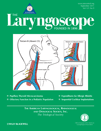Glucocorticoids regulate extracellular matrix metabolism in human vocal fold fibroblasts†‡
Presented at the 2011 Combined Otolaryngology Spring Meetings (COSM), Chicago, Illinois, U.S.A., April 27–May 1, 2011.
This work was funded by the National Institutes of Health/National Institute on Deafness and Other Communication Disorders (RO3 DC010267), Hackers for Hope, The Langeloth Foundation, and the Garban Fund. The authors have no other funding, financial relationships, or conflicts of interest to disclose.
Abstract
Objectives/Hypothesis:
Given the recent emergence of encouraging efficacy data regarding the utility of intralesional glucocorticoid (GC) injection for a variety of vocal fold pathologies, we sought to describe the location and expression pattern of the GC receptors within the vocal folds and quantify the effects of GCs on vocal fold fibroblasts.
Study Design:
In vitro, in vivo.
Methods:
Immunolocalization of the GC receptor was performed on normal rat vocal fold tissue. Receptor expression was also assayed in our human vocal fold fibroblast cell line. These cells were then treated with exogenous dexamethasone (DM) to quantify the effects of GCs on receptor expression, proliferation, transforming growth factor (TGF)-β–induced collagen secretion, and matrix protease synthesis.
Results:
Positive immunostaining for the GC receptor was found throughout the vocal fold with particularly strong staining in the epithelium and capillaries. Human vocal fold fibroblasts constitutively express the GC receptor, but this expression decreased in response to exogenous DM. DM also decreased fibroblast proliferation and TGF-β–induced collagen synthesis. DM also abrogated TGF-β–mediated effects on enzymes related extracellular matrix turnover.
Conclusions:
Our data are the first to provide mechanistic insight regarding the recently published favorable data regarding the utility of GCs in patients with vocal fold scar. Although further investigation is warranted, both the accessibility of this class of agents and the amenability to office-based procedures are likely to direct patient care models.




